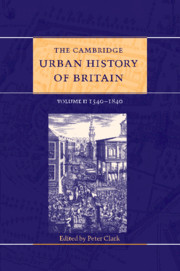Book contents
- Frontmatter
- 1 Introduction
- Part I Area surveys 1540–1840
- Part II Urban themes and types 1540–1700
- 5 Towns in an agrarian economy 1540–1700
- 6 Population and disease, estrangement and belonging 1540–1700
- 7 Politics and government 1540–1700
- 8 Reformation and culture 1540–1700
- 9 The urban landscape 1540–1700
- 10 London 1540–1700
- 11 Great and good towns 1540–1700
- 12 Ports 1540–1700
- 13 Small market towns 1540–1700
- Part III Urban themes and types 1700–1840
- Select Bibliography
- Index
- References
13 - Small market towns 1540–1700
from Part II - Urban themes and types 1540–1700
Published online by Cambridge University Press: 28 March 2008
- Frontmatter
- 1 Introduction
- Part I Area surveys 1540–1840
- Part II Urban themes and types 1540–1700
- 5 Towns in an agrarian economy 1540–1700
- 6 Population and disease, estrangement and belonging 1540–1700
- 7 Politics and government 1540–1700
- 8 Reformation and culture 1540–1700
- 9 The urban landscape 1540–1700
- 10 London 1540–1700
- 11 Great and good towns 1540–1700
- 12 Ports 1540–1700
- 13 Small market towns 1540–1700
- Part III Urban themes and types 1700–1840
- Select Bibliography
- Index
- References
Summary
on market days, the country came to town and the streets filled up – with buyers and sellers, cattle and sheep, cartloads of corn and bales of cloth; market places were packed with stalls, and the air was filled with the cries of frightened animals and the smell of dung. For many of the smallest market towns, this was the only day in the week when there was enough commercial bustle to make them look recognisably urban. Of course all pre-industrial towns were in some sense market towns, for all depended on public markets to supply themselves with food and raw materials, to bring in country people to deal in country products and so to patronise urban businesses, and to act as a focus for the broad spectrum of commercial and industrial activities which were the basis of the urban economy. However, for the purposes of this volume, London, larger towns, ports, leisure centres and other more specialised urban types have been assigned separate treatment, leaving this chapter to consider the life of the smaller and more nondescript inland settlements which formed the great majority of towns in this period. There were about 650 places with an operating market in England and Wales in the late sixteenth century, rising to nearly 800 a century later, and over 200 in Scotland. If we exclude perhaps ninety of this grand total because more appropriately described by some other label – provincial capital, county town, cathedral city, port – we are left with several hundred of these communities for which the term ‘market town’ sums up their essential character.
- Type
- Chapter
- Information
- The Cambridge Urban History of Britain , pp. 425 - 450Publisher: Cambridge University PressPrint publication year: 2000
References
- 6
- Cited by



